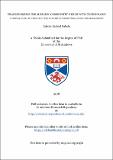Files in this item
Transforming the museum-community nexus with technology : a virtual museum infrastructure for participatory engagement and management
Item metadata
| dc.contributor.advisor | Miller, Alan | |
| dc.contributor.advisor | Hinrichs, Uta | |
| dc.contributor.author | Fabola, Adeola Ezekiel | |
| dc.coverage.spatial | xiii, 285 p. | en_US |
| dc.date.accessioned | 2019-05-17T13:29:32Z | |
| dc.date.available | 2019-05-17T13:29:32Z | |
| dc.date.issued | 2018-12-06 | |
| dc.identifier.uri | https://hdl.handle.net/10023/17718 | |
| dc.description.abstract | Museums play an important role in society as the custodians of heritage, and advances in technology have brought about opportunities for curating, preserving and disseminating heritage through virtual museums. However, this is not matched by an understanding of how these technologies can support these functions, especially given the varying levels of resources that museums have at their disposal. To address this problem, a hybrid methodology which combines underpinning theory and practice has been adopted. Initial investigation of the problem takes place through a contextualisation of museology and heritage studies, followed by exploratory case studies that yield design objectives for a Virtual Museum Infrastructure (VMI). A design of the VMI is proposed based on these objectives, and the VMI is instantiated, deployed and evaluated in real-world scenarios using a combination of quantitative and qualitative techniques. The findings of this investigation demonstrate that the use of technology provides new opportunities for engagement with heritage, as experts and community members alike can create, curate and preserve content, which can then be disseminated in engaging ways using immersive, yet affordable technologies. This work therefore demonstrates how technology can be used to: (1) support museums in the creation, curation, preservation and dissemination of heritage, through a VMI that provides support for all the stages of the media life cycle, (2) facilitate active use, so that content that is created once can be reused on multiple platforms (for example on the web, on mobile apps and in on-site installations), and (3) encourage connectivity by linking up local museums using a location-aware interface and facilitates the consumption content using digital literacies available to the public. The aforementioned points, coupled with the system instantiations that demonstrate them, represent the contributions of this thesis. | en_US |
| dc.language.iso | en | en_US |
| dc.publisher | University of St Andrews | |
| dc.subject.lcc | AM7.F23 | en |
| dc.subject.lcsh | Virtual museums | en |
| dc.subject.lcsh | Museums--Data processing | en |
| dc.subject.lcsh | Museums--Information technology | en |
| dc.title | Transforming the museum-community nexus with technology : a virtual museum infrastructure for participatory engagement and management | en_US |
| dc.type | Thesis | en_US |
| dc.contributor.sponsor | University of St Andrews. School of Computer Science | en_US |
| dc.type.qualificationlevel | Doctoral | en_US |
| dc.type.qualificationname | PhD Doctor of Philosophy | en_US |
| dc.publisher.institution | The University of St Andrews | en_US |
This item appears in the following Collection(s)
Items in the St Andrews Research Repository are protected by copyright, with all rights reserved, unless otherwise indicated.

